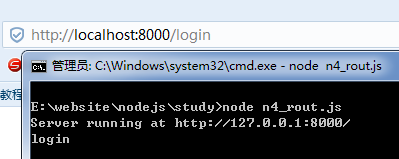nodejs basic application
1. The first nodejs application
n1_hello.js
console.log('hello word!');
Execute the file in the command line cmd (Open the command line at this file):
node n1_hello.js
Return the result from cmd on the command line:
hello word!
2. Basic format of nodejs
//步骤一:引入require模块,require指令载入http模块
var http = require('http');
//步骤二:创建服务器
http.createServer(function (request, response) {
// 发送 HTTP 头部
// HTTP 状态值: 200 : OK
// 内容类型: text/html
response.writeHead(200, {'Content-Type': 'text/html;chaset=utf-8;'});
//步骤三:接受请求与响应请求
if(request.url!=='/favicon.ico'){
......
// 发送响应数据
response.end('');//必须有,没有则没有协议尾
}
}).listen(8000);
// 终端打印如下信息
console.log('Server running at http://127.0.0.1:8000/');
3. Nodejs calling function
----------------- Call local function--------------------------------
var http = require('http');
http.createServer(function (request, response) {
response.writeHead(200, {'Content-Type': 'text/html;chaset=utf-8;'});
if(request.url!=='/favicon.ico'){
fun1(response);
// 发送响应数据
response.end('');
}
}).listen(8000);
// 终端打印如下信息
console.log('Server running at http://127.0.0.1:8000/');
function fun1(res){
console.log('fun1');
res.write('hello,我是fun1');
}
-----------------Call external functions-----------------------------
Note: External functions must be written in module.exports, exports is the interface exposed by the module
------------(1) Only call one function- ----------
In the main program:
var http = require('http');
var otherfun = require("./models/otherfuns.js");//调用外部页面的fun2
http.createServer(function (request, response) {
response.writeHead(200, {'Content-Type': 'text/html;chaset=utf-8;'});
if(request.url!=='/favicon.ico'){
otherfun(response);//支持一个函数时
response.end('');
}
}).listen(8000);
// 终端打印如下信息
console.log('Server running at http://127.0.0.1:8000/');
otherfuns.js
function fun2(res){
console.log('fun2');
res.write('你好!,我是fun2');
}
module.exports = fun2;//只支持一个函数
------------(2) Call multiple functions-----------
Main program Medium:
var http = require('http');
var otherfun = require("./models/otherfuns.js");//调用写函数的外部页面otherfuns.js
http.createServer(function (request, response) {
response.writeHead(200, {'Content-Type': 'text/html;chaset=utf-8;'});
if(request.url!=='/favicon.ico'){
//todo 以对象.方法名调用
otherfun.fun2(response);
otherfun.fun3(response);
//todo 以字符串调用对应函数(结果同上)
//otherfun['fun2'](response);
//otherfun['fun3'](response);
response.end('');
}
}).listen(8000);
// 终端打印如下信息
console.log('Server running at http://127.0.0.1:8000/');
}
otherfuns.js Medium
module.exports={
fun2:function(res){//匿名函数
console.log('fun2');
res.write('你好!,我是fun2');//在页面中输出
},
fun3:function(res){
console.log('fun3');
res.write('你好!,我是fun3');
},
......
}4. Preliminary nodejs routing
Main program n4_rout.js:
var http = require('http');
//引入url模块
var url = require('url');
http.createServer(function (request, response) {
response.writeHead(200, {'Content-Type': 'text/html;chaset=utf-8;'});
if(request.url!=='/favicon.ico'){
var pathname = url.parse(request.url).pathname;
pathname=pathname.replace(/\//,'');//替换掉前面的/
console.log(pathname);
response.end('');
}
}).listen(8000);
// 终端打印如下信息
console.log('Server running at http://127.0.0.1:8000/');
Execute the file in the command line cmd, access: http://localhost:8000/, enter the routing address here, as shown below, and observe Command Line.

5. Nodejs reads files
Main program:
var http = require('http');
var optfile=require('./models/optfile');//导入文件
http.createServer(function (request, response) {
// 发送 HTTP 头部
// HTTP 状态值: 200 : OK
// 内容类型: text/html
response.writeHead(200, {'Content-Type': 'text/html;chaset=utf-8;'});
if(request.url!=='/favicon.ico'){//清除第2次访问
optfile.readfileSync('./views/login.html');//同步调用读取文件readfileSync()方法
//optfile.readfile('./views/login.html',response);//异步步调用读取文件readfile()方法
response.end('ok!!!!!');//todo 不写没有协议尾
console.log('主程序执行完毕!');
}
}).listen(8000);
// 终端打印如下信息
console.log('Server running at http://127.0.0.1:8000/');
optfile In .js:
var fs=require('fs');//Node 导入文件系统模块(fs)语法 导入fs操作文件的类
module.exports={
readfileSync:function(path){
// 同步读取
var data = fs.readFileSync(path,'utf-8');//以中文读取同步文件路径path
console.log("同步方法执行完毕。");
},
readfile:function(path){
// 异步读取
fs.readFile(path,function (err, data) {
if (err) {
console.error(err);
}else{
console.log("异步读取: " + data.toString());
}
});
console.log("异步方法执行完毕。");
},
}
Result: In command line cmd
(1) When reading the file synchronously:

(2) When reading files asynchronously: (commonly used)

In the web page: all are:

The above is the entire content of this article. I hope that the content of this article can bring some help to everyone's study or work. I also hope to support the PHP Chinese website!
For more articles related to nodejs basic applications, please pay attention to the PHP Chinese website!

Hot AI Tools

Undresser.AI Undress
AI-powered app for creating realistic nude photos

AI Clothes Remover
Online AI tool for removing clothes from photos.

Undress AI Tool
Undress images for free

Clothoff.io
AI clothes remover

Video Face Swap
Swap faces in any video effortlessly with our completely free AI face swap tool!

Hot Article

Hot Tools

Notepad++7.3.1
Easy-to-use and free code editor

SublimeText3 Chinese version
Chinese version, very easy to use

Zend Studio 13.0.1
Powerful PHP integrated development environment

Dreamweaver CS6
Visual web development tools

SublimeText3 Mac version
God-level code editing software (SublimeText3)

Hot Topics
 The difference between nodejs and vuejs
Apr 21, 2024 am 04:17 AM
The difference between nodejs and vuejs
Apr 21, 2024 am 04:17 AM
Node.js is a server-side JavaScript runtime, while Vue.js is a client-side JavaScript framework for creating interactive user interfaces. Node.js is used for server-side development, such as back-end service API development and data processing, while Vue.js is used for client-side development, such as single-page applications and responsive user interfaces.
 Is nodejs a backend framework?
Apr 21, 2024 am 05:09 AM
Is nodejs a backend framework?
Apr 21, 2024 am 05:09 AM
Node.js can be used as a backend framework as it offers features such as high performance, scalability, cross-platform support, rich ecosystem, and ease of development.
 How to connect nodejs to mysql database
Apr 21, 2024 am 06:13 AM
How to connect nodejs to mysql database
Apr 21, 2024 am 06:13 AM
To connect to a MySQL database, you need to follow these steps: Install the mysql2 driver. Use mysql2.createConnection() to create a connection object that contains the host address, port, username, password, and database name. Use connection.query() to perform queries. Finally use connection.end() to end the connection.
 What are the global variables in nodejs
Apr 21, 2024 am 04:54 AM
What are the global variables in nodejs
Apr 21, 2024 am 04:54 AM
The following global variables exist in Node.js: Global object: global Core module: process, console, require Runtime environment variables: __dirname, __filename, __line, __column Constants: undefined, null, NaN, Infinity, -Infinity
 What is the difference between npm and npm.cmd files in the nodejs installation directory?
Apr 21, 2024 am 05:18 AM
What is the difference between npm and npm.cmd files in the nodejs installation directory?
Apr 21, 2024 am 05:18 AM
There are two npm-related files in the Node.js installation directory: npm and npm.cmd. The differences are as follows: different extensions: npm is an executable file, and npm.cmd is a command window shortcut. Windows users: npm.cmd can be used from the command prompt, npm can only be run from the command line. Compatibility: npm.cmd is specific to Windows systems, npm is available cross-platform. Usage recommendations: Windows users use npm.cmd, other operating systems use npm.
 Is there a big difference between nodejs and java?
Apr 21, 2024 am 06:12 AM
Is there a big difference between nodejs and java?
Apr 21, 2024 am 06:12 AM
The main differences between Node.js and Java are design and features: Event-driven vs. thread-driven: Node.js is event-driven and Java is thread-driven. Single-threaded vs. multi-threaded: Node.js uses a single-threaded event loop, and Java uses a multi-threaded architecture. Runtime environment: Node.js runs on the V8 JavaScript engine, while Java runs on the JVM. Syntax: Node.js uses JavaScript syntax, while Java uses Java syntax. Purpose: Node.js is suitable for I/O-intensive tasks, while Java is suitable for large enterprise applications.
 Is nodejs a back-end development language?
Apr 21, 2024 am 05:09 AM
Is nodejs a back-end development language?
Apr 21, 2024 am 05:09 AM
Yes, Node.js is a backend development language. It is used for back-end development, including handling server-side business logic, managing database connections, and providing APIs.
 Which one to choose between nodejs and java?
Apr 21, 2024 am 04:40 AM
Which one to choose between nodejs and java?
Apr 21, 2024 am 04:40 AM
Node.js and Java each have their pros and cons in web development, and the choice depends on project requirements. Node.js excels in real-time applications, rapid development, and microservices architecture, while Java excels in enterprise-grade support, performance, and security.






